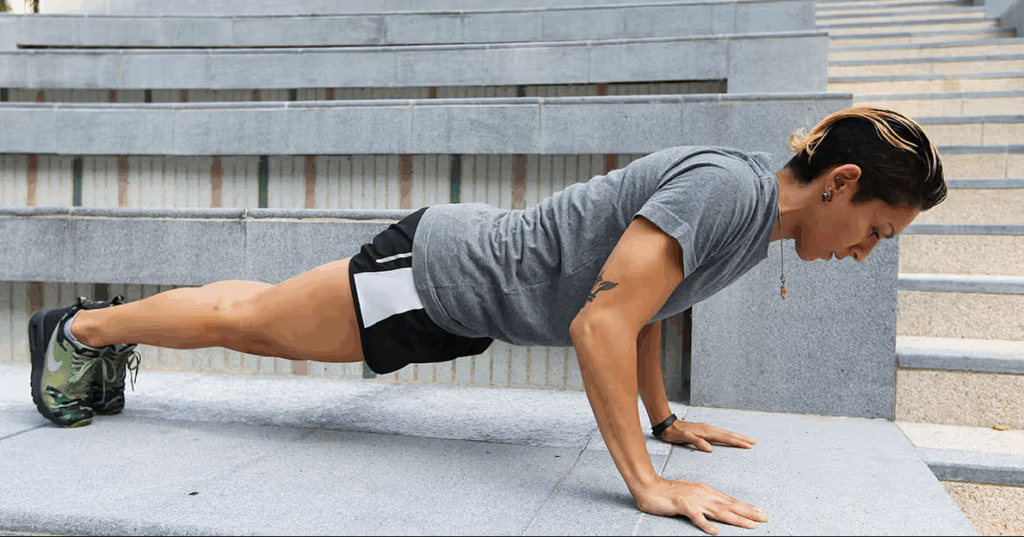Plyometric push-ups build explosive strength by engaging fast-twitch muscle fibers through rapid stretch-shortening cycles. Start with beginner variations like incline or small-height push-ups before progressing to more advanced techniques such as clap push-ups or depth push-ups. Keep your sessions to 2-3 times weekly with three sets of 5-8 reps, focusing on quality over quantity. For maximum benefits, pair these explosive movements with complementary bodyweight exercises.
The techniques below will transform your upper body power without any equipment.
The Science Behind Explosive Push-Up Training
When you perform plyometric push-ups, your muscles rapidly shift between eccentric and concentric contractions, triggering what exercise physiologists call the stretch-shortening cycle. This physiological mechanism enhances your explosive strength by utilizing stored elastic energy in your muscle tissues.
Your fast-twitch muscle fibers are responsible for power production. You activate them at markedly higher rates during plyometric push-ups than during standard variations. Research indicates this activation pattern leads to greater improvements in muscle power and athletic performance over time.
What’s often overlooked is how these movements engage your entire kinetic chain. While your chest, shoulders, and triceps do the pushing, your core stability becomes essential for maintaining proper alignment and transferring force efficiently. This full-body integration explains why plyometrics deliver such thorough strength benefits without equipment.

Beginner-Friendly Plyometric Push-Up Variations
Not everyone starts with the explosive strength to perform advanced plyometric variations. New to this type of bodyweight exercise? Kick things off with incline push-ups against a stable surface, followed by low-level push-ups where your hands rest a bit higher than the floor.
Move on to “bounce” push-ups that introduce the plyometric element without full explosive power. Keep proper form during each movement to stimulate muscles. For effective power development, start with three sets of 5-8 reps, then increase as your strength increases.
Exercise progression requires patience. Learn each variation, then move on to harder ones. You will adapt and gain the foundation for advanced plyometric movements.

Advanced Plyometric Techniques for Maximum Power
After mastering some basic plyometric push-ups, you can progress to more difficult techniques to increase your power output and strength gains. Try adding one-arm plyometric push-ups to create asymmetrical loading that tests your stabilizing muscles and core strength.
Resistance-loaded plyometric push-ups with a weight vest or plate on your back work the upper body while maintaining explosive movements. Add depth to push-ups by dropping from an elevated position before explosively pushing up for elite athletic conditioning.
For progressive overload, gradually raise your feet on boxes or steps to increase the height of your push-up variations. The triple clap push-ups take extraordinary power. Push off strong enough that you can clap in front, behind your back, and in front again when you land.
Programming Plyometric Push-Ups for Optimal Results
Besides learning advanced techniques, structuring your plyometric training properly determines whether you make explosive strength gains or just burn yourself out. Limit plyometric push-ups to 2-3 weeks per week with 48 hours between workouts for recovery.
Partner plyometrics with other functional training moves. Do this circuit of plyometric push-ups, bodyweight squats, and core work. Adjust training intensity based on recovery. Persistent fatigue means you need more rest between sessions.

Combining Plyometrics With Other Bodyweight Exercises
Plyometric push-ups alone produce impressive upper body power gains but are more effective when combined with complementary bodyweight exercises. Plan out plyometric push-ups in between pulling movements like inverted rows and core exercises to build stability at home.
A powerful combination can start with five plyometric push-ups, work up to 10-12 bodyweight squats, and finish with 30-45 seconds of hollow body holds. In this sequence, you complete a mini-circuit testing different muscle groups with a steady heart rate.
Alternate explosive movements with slower, controlled exercises for best results. Contrast training stimulates many different energy systems without overloading specific muscle groups, which helps develop full-body functional strength.
Frequently Asked Questions
Can Plyometric Push-Ups Help Improve My Regular Push-Up Numbers?
Yes, they greatly boost your push-up numbers by developing explosive power and fast-twitch muscle fibers. You’ll strengthen the same muscles used in regular push-ups while improving your overall pushing capacity and endurance.
Should I Do Plyometric Push-Ups on Consecutive Days?
No, you shouldn’t do plyometric push-ups on consecutive days. Your muscles need 48-72 hours to recover from this high-intensity exercise. Schedule them 2-3 times weekly with rest days in between for ideal results.
How Do Plyometric Push-Ups Compare to Weight Training for Strength?
Plyometric push-ups build explosive power and speed, while weights develop maximal strength. You’ll gain functional strength with plyometrics, but you’ll achieve greater overall muscle mass and absolute strength through progressive weight training.
Can Plyometric Push-Ups Help Reduce Shoulder Pain?
No, plyometric push-ups won’t reduce shoulder pain. They’re high-impact exercises that can actually worsen existing issues. If you’re experiencing shoulder pain, you should seek gentler rehabilitation exercises and consult a physical therapist.
Are Plyometric Push-Ups Suitable for Older Adults?
Proceed with caution if you’re an older adult. You’ll need good joint health and prior strength training experience. Modified versions like incline plyometrics or reduced intensity options might be safer for you.








